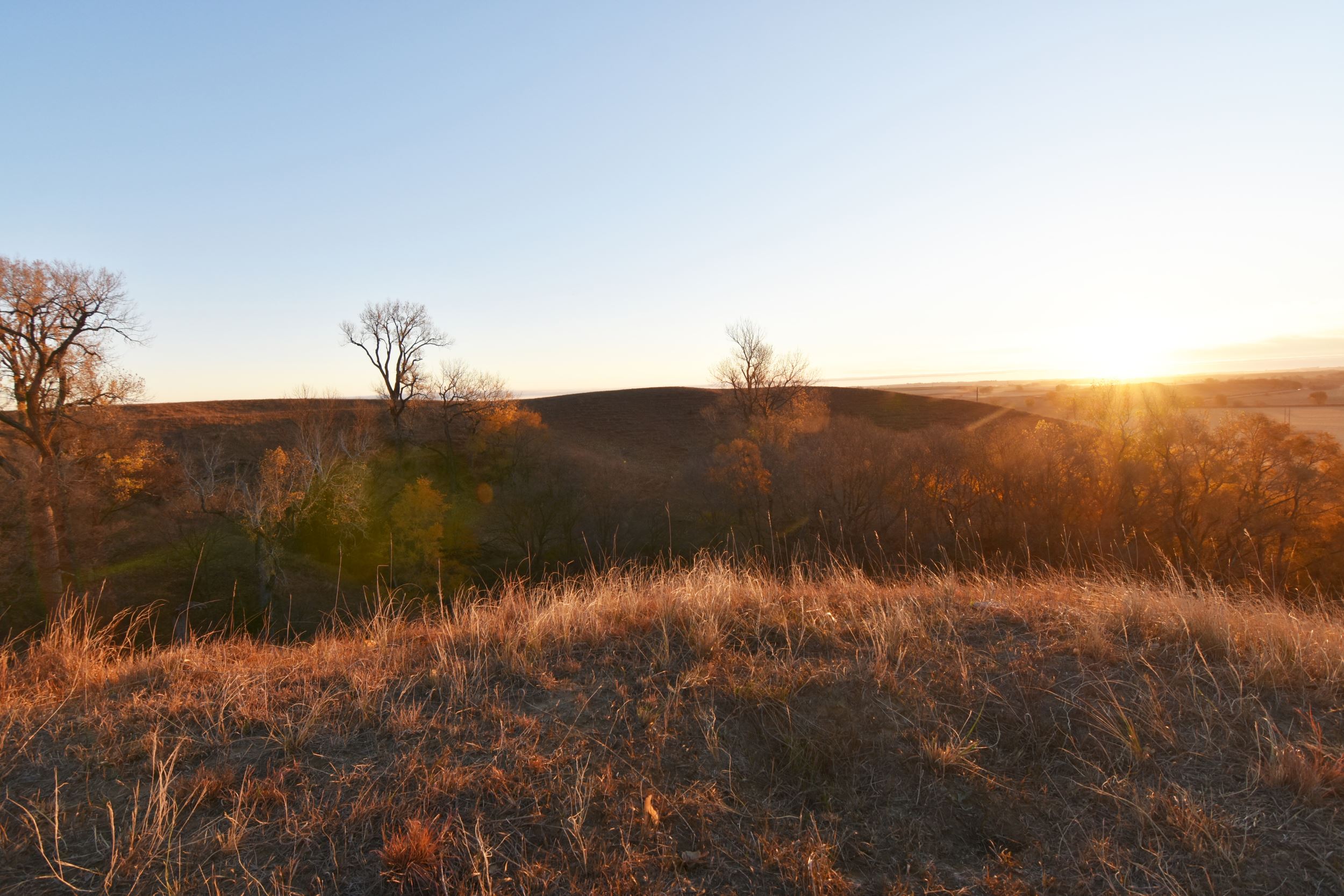Heritage in the Hills
By Mack Swenson on January 10, 2023 in Landowner Stories

Erica Place/INHF
Tens of thousands of years ago, winds lifted grains of silt and sand from the Missouri River valley and deposited them on the river’s eastern bank. The resulting hills, which have been further shaped by the eroding force of water, are only found to such depth and extent along a 200-mile stretch of the Missouri River in Iowa and in certain regions of China.
Now, these rolling hills along the state’s western border contain much of Iowa’s remaining remnant prairie—land that has never been plowed or developed—of which there is less than one-tenth of 1 percent left. A piece of that remnant prairie near Sioux City and Sergeant Bluff, on the northern end of the Loess Hills, will now be protected thanks to the generous donation of Scott and Sandra Wendel, of Waterloo, Nebraska.
Their 113 acres of Loess Hills remnant prairie near the Sioux City metro is a gift that will bear fruit—in a literal and figurative sense—throughout the region. Seeds from the Wendels’ remnant prairie will be used in future prairie plantings and restoration projects.
The gift property lies off Old Highway 141 along Whiskey Creek near Bronson and spans west for a mile to Carroll Avenue along the front range of the Loess Hills. Recently the Wendel corn crib, built in 1959, a familiar landmark along Old Highway 141, blew down in a storm last December.
Prairie enthusiast, conservationist and INHF supporter Glenn Pollock planted a seed when he approached the Wendels about considering protecting the remnant prairie that overshadowed the lower settling basin of corn and bean fields. Prior to that conversation, the couple was unaware of INHF and the possibility of donating their land. But that seed took root four years later when the Wendels were ready to part ways with the land—a testament to the power of advocates like Pollock.
Scott learned about the rarity of the Loess Hills when he was a young adult, and he recalls feeling a sense of pride that his family lived and farmed on this land. Traversing the land mainly by horse, Scott would ride to the top of the ridge and gaze out at Iowa, Nebraska and South Dakota. This view, as well as the hills’ unique east-west orientation, distinguishes the property even from other Loess Hills prairie.
Scott’s grandfather purchased large expanses of contiguous farmland clustered around the original homestead that included the Loess Hills front range, starting in 1912. The farm was designated a Century Farm by the State of Iowa in 2012. The original operation once spanned over 2,000 acres where Scott’s grandfather, Vern, and his father, Al, farmed and raised cattle and hogs along with crops to feed the livestock.
 The Loess Hills gift property will be known as the Wendel Prairie Preserve.
The Loess Hills gift property will be known as the Wendel Prairie Preserve.
After attending college at the University of Iowa, Scott and Sandra settled in Omaha. However, even while away, the property held a special place in Scott’s heart.
“I grew up in these hills, herding cattle on horseback. Those memories are what life is about, and our family is honored to preserve this precious footprint forever through the Foundation,” Scott said.
On a recent trip to harvest seed on the hills, he fondly recalled a huge grove of cottonwoods on the west side of the cropland where the cattle that once grazed there would find shade. He recalls not so fondly the many hours baling hay and doing farm chores. Escape into the solemn hills provided boyhood distraction and still today an expansive vista unfolds among the prairie grasses and creatures living there.
When their hills were threatened by unwanted development in the early 2000s, the couple commissioned a biological survey of the land. The botanists and entomologists from Briar Cliff University came back with a phenomenal review, demonstrating to the couple the biological rarity of this land.
“We didn’t realize how rich this hill was in wildlife, rare wildflowers and insects until we had that assessment,” Sandra said.
Consistent with the assessment, a brief hike by INHF staff identified over 58 native prairie plants in one day—a number expected to grow after management efforts like prescribed fire.
“This property will be a great stewardship asset for a seed source, as well as housing a diverse biological community for all of our wildlife,” said Loess Hills Land Stewardship Director Kody Wohlers. The prairie is high quality and features minimal encroachment from undesirable brush or invasive trees like Eastern red cedars.
“Families like the Wendels, that are thinking about what this property will be in 50 or 100 years, are the people that make the work of INHF possible,” said the organization’s president Joe McGovern. “Conservation in Iowa happens when people care about the next generation of people, plants and animals.”
Although the land will not be open to the public, Wohlers said INHF plans to host volunteer events on the property where people can help to harvest native prairie seed. Educational events, nature hikes, bird surveys, and research are also possibilities.
Permanent protection of this property ensures this precious prairie is never developed.
Last but certainly not least, the donation adds to a legacy of protected lands in the Loess Hills that keeps building acre by acre, hill by hill — almost like the way a trillion grains of sand are molded into an awe-inspiring natural mandala by ancient winds.